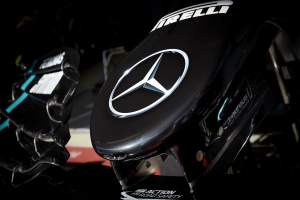Daimler boss Ola Kallenius says Mercedes “never seriously considered pulling out” of Formula 1 despite constant speculation to the contrary, but it did identify “four pillars” needed to guarantee its participation.
The Mercedes F1 team announced on Friday morning that Daimler has sold a large part of its 60% stake to become equal-thirds partners with team boss Toto Wolff and new investor INEOS.
It means Daimler has sacrificed some of its control and share of the team’s eventual profits in return for shoring up its long-term future in F1, which is set to become a profit-making exercise for the world champion team in the coming years under new cost cap and revenue distribution rules.
Speaking on Friday afternoon after the announcement, Kallenius told a media call including The Race that while there was “some speculation in the press, we never seriously considered pulling out because it’s such a strong part of our heritage”.
But he admitted “we did ask ourselves in the board, what are the pillars that make up Formula 1 and beyond the emotional connection to the sport, how do you look at this from a rational point of view?”.
Kallenius said Daimler “came up with four pillars that you need to answer”, which have been satisfied through a combination of F1’s on-track product and its off-track plans, including efforts to improve the financial proposition for teams and create a clear sustainability roadmap.
“And with those four pillars, to me the decision is clear: we’re in.” :: Ola Kallenius
“The number one is how’s the show, is the show good? And what about the fanbase?” said Kallenius.
“And what we have particularly seen in the latest year through social media is really an explosion in the reach.
“The best news is that the younger fans are coming, 15 to 30 year olds through esports, through social media, through a great show.
“And I don’t know a motorsport spectacle that is better than F1. That was question number one.”
Daimler’s second point was achieving carbon neutrality. Daimler and Mercedes have mapped out a Vision 2039 strategy and a desire to achieve a CO2 neutral future within two decades and Kallenius said there “has to be a critical path towards sustainable motorsports”.
Mercedes’ F1 team announced its own sustainability plan earlier this year, becoming the first grand prix outfit to do so.
In addition to F1 reducing its carbon footprint, Daimler also wanted to be satisfied with its technological advancements including increasing the electrical component of the current V6 turbo-hybrid engines.
“I can see the electrical part increasing, I can see it being a testing ground for lower carbon, or no carbon fuels, which will play some role in the world going carbon neutral, eventually,” said Kallenius.
“So that second point, can you credibly make the sport more sustainable? I believe yes, and we’re certainly committed to it.”
Sustainability was also a key concern on the financial side, which Kallenius identified as the third pillar.
Daimler has gradually been weaning off its contribution to the Mercedes F1 team as sponsorship and prize money revenue has taken care of the vast majority of the budget.
It is not yet cost-neutral to Daimler and therefore continues to exist as an expense, even if it was at a level Kallenius found very attractive. So Daimler wanted to identify how F1 could bring spending under control.
F1’s incoming $145m cost cap “helps”, said Kallenius. “We were an advocate for it. It makes the economic proposition better”. Further progress is desired though to rein in power unit spending.
The fourth and final pillar was linked to that as Kallenius described it as whether F1 always had to be “a cost centre, or can it be a sports franchise?” – a reference to a works team draining resources or being a profit-maker.
This is relevant to Mercedes’ new shareholding structure, as while Daimler will get a smaller share of the profits than if it retained its 60% stake, it can expect to maintain those profits longer-term as the cost burden is shared between three parties.
That will allow Daimler to bank on its Mercedes works F1 team as a long-term profit-making entity rather than justify a financial burden – an outcome Kallenius now says is “tangible”.
“We can see now that people are starting to look at this, more like sports franchises,” said Kallenius.
“Getting a great strong professional partner that knows professional sport like INEOS into the picture, the fact that somebody like Jim makes a decision to join forces with us, I think reinforces that fourth pillar.
“And with those four pillars, to me the decision is clear: we’re in.”




